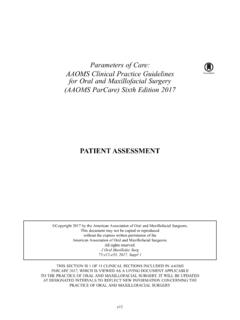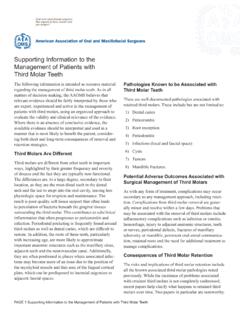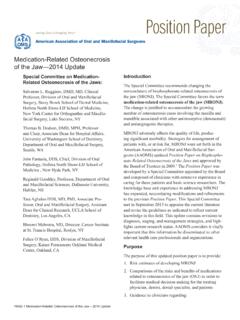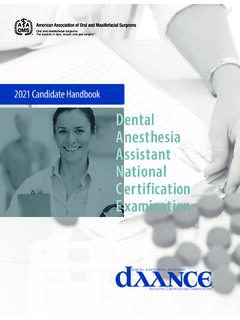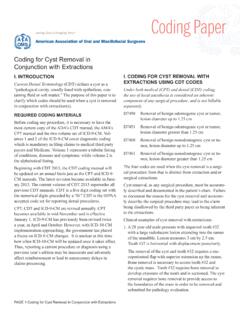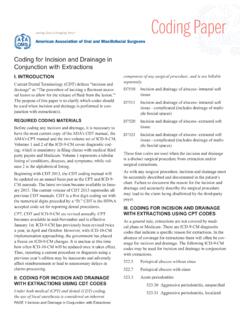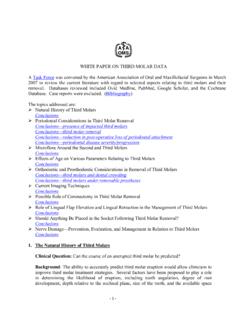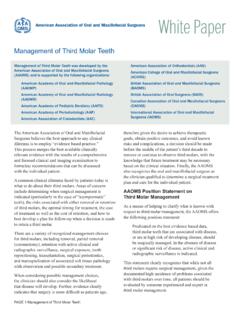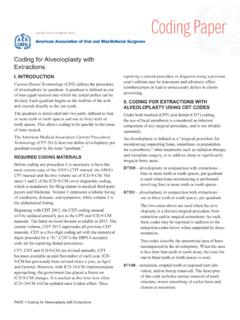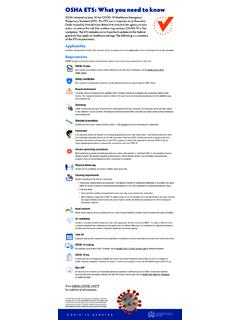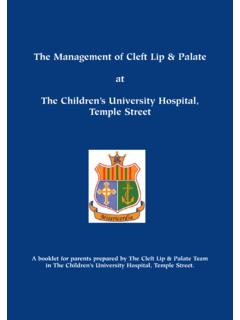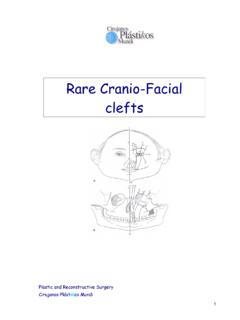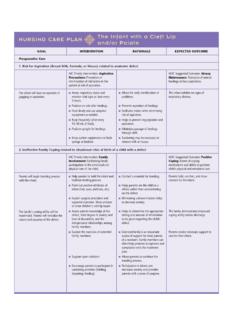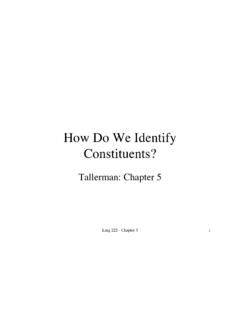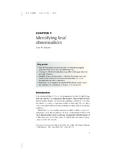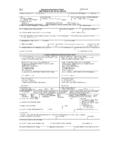Transcription of Coding for Cleft Lip and Palate Surgery - AAOMS
1 Coding for Cleft Lip and Palate SurgeryI. INTRODUCTIONF amiliarity and compliance with the previous papers, particularly the AAOMS paper on ICD-9-CM Diagnostic Coding and Procedural Coding Guidelines Utilizing CPT, HCPCS, and CDT are necessary in using these codes successfully. This paper is divided into three parts patterned after the chronological evaluation of a Cleft lip and Palate EVALUATION AND MANAGEMENT SERVICESThe CPT Guidelines totally revised the universe of eval-uation and management codes in 1992. The specifics of these revisions have been covered by other publications specifically dedicated to the evaluation and management (E/M) codes.
2 The important point of consideration is that the initial examinations of patients with Cleft lip and Cleft Palate problems should appropriately be coded using the E/M codes. Particular attention should be directed to the location where the service is provided. It is not uncommon to initially have contact with Cleft lip and Palate patients in a newborn nursery within a hospital. However, the great majority of patients will be seen on an outpatient basis in an OMS office. Specific subsets of codes are designated by American Medical Association has outlined the concept of a specialty-specific examination in the CPT book. This concept enables subspecialties within medicine to use the high level E/M codes for the initial examination.
3 Required with these codes is the completion and docu-mentation of a comprehensive OMS examination. In the case of a Cleft lip and Palate patient, this would include not only a soft tissue exam, a musculoskeletal exam, speech and hearing evaluation and appropriate imaging, but also a comprehensive dental faces|changing lives PAGE 1 Coding for Cleft Lip and Palate SurgeryIII. Coding FOR Cleft SURGICAL SERVICESThe codes for describing Cleft lip and Cleft Palate Surgery are found within the Digestive System Section of the CPT Manual. The following codes are to be used for Cleft lip Surgery :40650 Repair lip, full thickness; vermillion only40652 Repair Lip, full thickness, up to half vertical height40654 Repair Lip, full thickness over one-half vertical height, or complex40700 Plastic repair of Cleft lip/nasal deformity.
4 Prima-ry, partial or complete, unilateral40701 primary bilateral, one stage procedure40702 primary bilateral, one of two stages40720 Secondary repair of Cleft lip/nasal, by recreation of defect and reclosure40761 with cross lip pedicle flap (Abbe-Estlander type), including sectioning and inserting pedicle40799 Unlisted procedure, lips ( , lip adhesions)Frequently, additional reconstructive soft tissue procedures need to be performed. Codes for these procedures include:14040 Adjacent tissue transfer or rearrangement, fore-head, cheeks, chin mouth, neck, axillae, genita-lia, hands and/or feet; defect 10sq cm or less14041 defect sq cm to sq Adjacent tissue transfer or rearrangement, eye-lids, nose, ears, and/or lips; defect 10 sq cm or less14061 defect sq cm to sq cm15120 - 15261 (additional reconstructive codes under the Integumentary System)15576 Formation of direct or tubed pedicle, with or without transfer.
5 Eyelids, nose, ears, lips, or intraoralCodes used to describe Cleft Palate Surgery (Codes are located in the Digestive System heading under the Section of Palate and Uvula) to include the alveolus, anterior/pos-terior hard Palate and soft Palate , are as follows: 42200 Palatoplasy for Cleft Palate , soft and/or hard Palate only 42205 Palatoplasty for Cleft Palate , with closure of alve-olar ridge; soft tissue only42210 Palatoplasty for Cleft Palate with bone graft to alveolar ridge (includes obtaining graft). This includes grafting from the alveolar crest to the piriform rim. Note 1: To report a bone graft to an al-veolar Cleft as a secondary procedure for ridge augmentation, without a palatoplasty, use code 21210.
6 For example: a child had a successful alveolar graft at 9 years old, patient is now ready for a dental implant. Additional bone stock is needed to support the dental implant. Note 2: When a separate surgeon harvests the bone or other tissues through a separate skin incision use code 20902. See below Note 3: regarding bilateral clefts. The modifier -50 would logically apply, howev-er, the Medicare, Medically Unlikely Edit (MUE) policy prohibits using the bilateral modifier with the 42210. Therefore; there is no distinction between repair of a unilateral and bilateral alveolar Cleft and there is not a separate bilateral Cleft code. You may consider using the -22 (unusual difficulty) modifier for bilateral clefts.
7 Note 4: codes 42200, 42205, 42210, 30600 and 42260 cannot be used together as a result of the Correct Coding Initiative (CCI edits). However; it is appropriate to use the modifier -59, if the services are distinctly separate. For example, regarding a patient with a naso-alveolar Cleft and a oronasal fistula of the posterior hard Palate (repair of the naso-alveolar fistula extending into the anterior hard Palate /premaxilla and the PAGE 2 Coding for Cleft Lip and Palate Surgerynaso-labial fistula is considered integral to the alveolar Cleft repair). If you choose to repair of a naso-alveolar Cleft and oral na-sal fistula of the posterior hard Palate at the same time.
8 Using 42210-59, 30600-59 (or 42200-59 as appropriate) is acceptable, if denied an appeal is Extraction of teeth during Cleft Palate Surgery . Specify difficulty with ICD-9/10 code. For example: removal of an impacted supernumerary tooth in the Cleft ( ) or removal of a decayed erupted primary incisor in the Cleft ( ).42215 Palatoplasty for Cleft Palate ; major revision42220 Palatoplasty for Cleft Palate , secondary lengthen-ing procedure42225 Palatoplasty for Cleft Palate , attachment pharyn-geal flap42226 Lengthening of Palate and pharyngeal flap42227 Lengthening of Palate , with island flap42235 Repair of anterior Palate , including vomer flap42260 Repair of nasolabial fistula 20902 Bone harvest any area, major or large.
9 Code used for obtaining autogenous bone or other tissues through a separate skin incision by a separate surgeon than performing the primary procedure. If the primary procedure includes obtaining the graft use the -52 modifier on the primary procedure for reduced services or both surgeons may report the primary procedure code appended by the -62 modifier. For example: sur-geon #1 repairs a unilateral Cleft : use 42210-52. Surgeon #2 harvest bone from the iliac crest and does not assist in the Surgery : use 20902-6230580 Repair fistula; oromaxillary (combine with 31030 if antrotomy is included)30600 Repair oral-nasal fistulaAdditional procedure codes include:30400-30630 Rhinoplasty, septoplasty, nasal region repair codesCoding PaperPAGE 3 Coding for Cleft Lip and Palate SurgeryCoding PaperRecommendations by the AAOMS Committee on Health Care and Advocacy (CHCA) for procedures used for treating patients with Cleft lip and Palate deformities for which there are no specific CPT codes:Prosthethetic devices used as adjuncts for Cleft lip and Palate treatment:42280 Maxillary impression for palatal prosthesis.
10 Use 42280 for taking an impression in the office, you may choose to use the -22 modifier if the impres-sion is made under Insertion palatal prosthesis: use 42281 if the prosthesis is fabricated by a laboratory (NOT by the provider) and delivered/inserted by the provider where limited adjustments are required. 21085 Impression and custom preparation of oral surgi-cal splint: The AAOMS CHCA does NOT recommend the use of this code for Cleft Palate prosthesis. This code should be used for provider fabricated splints in conjunction with orthognathic Surgery . 21084 Speech aid prosthesis21076 Prepare facial/oral prosthesis: includes taking impression(s), custom preparation and delivery/insertion for the prosthesis.
